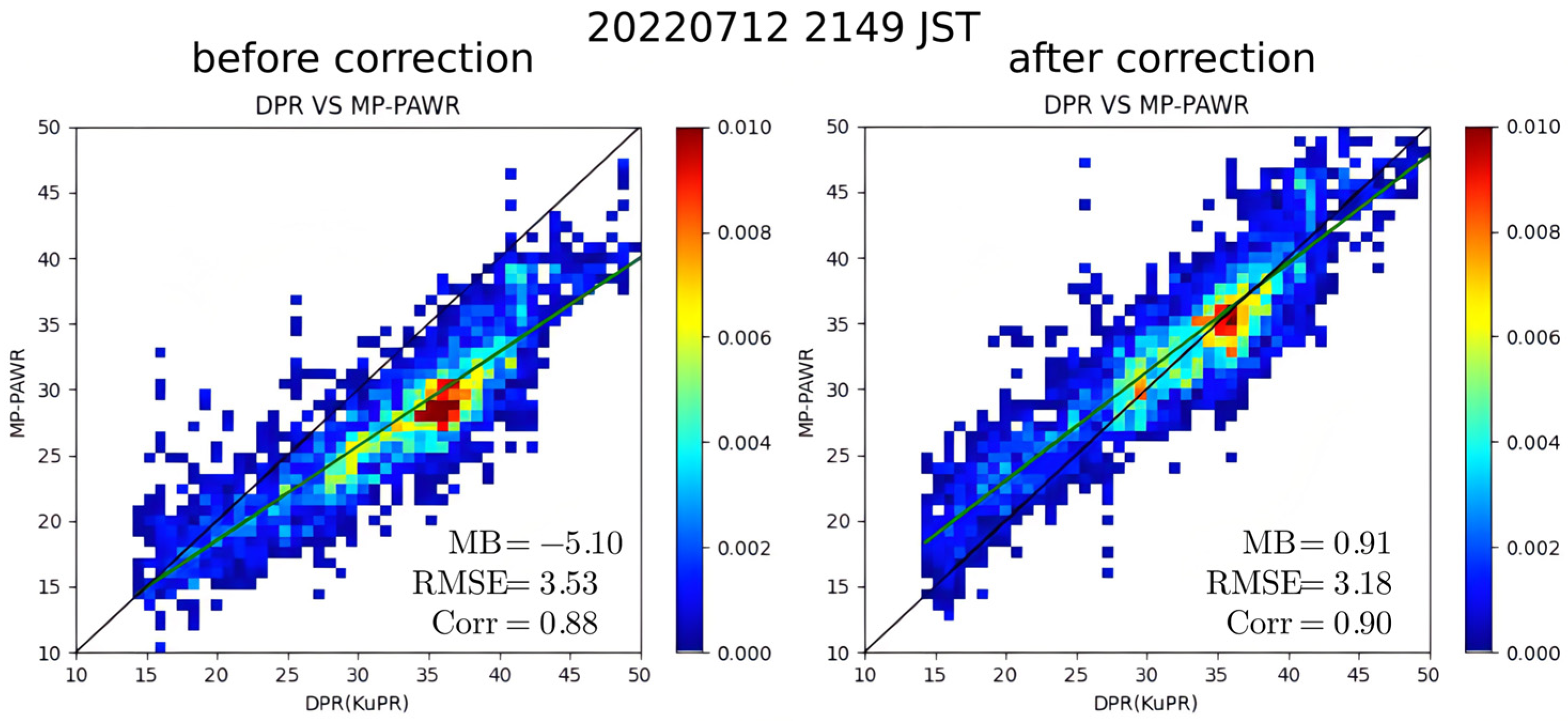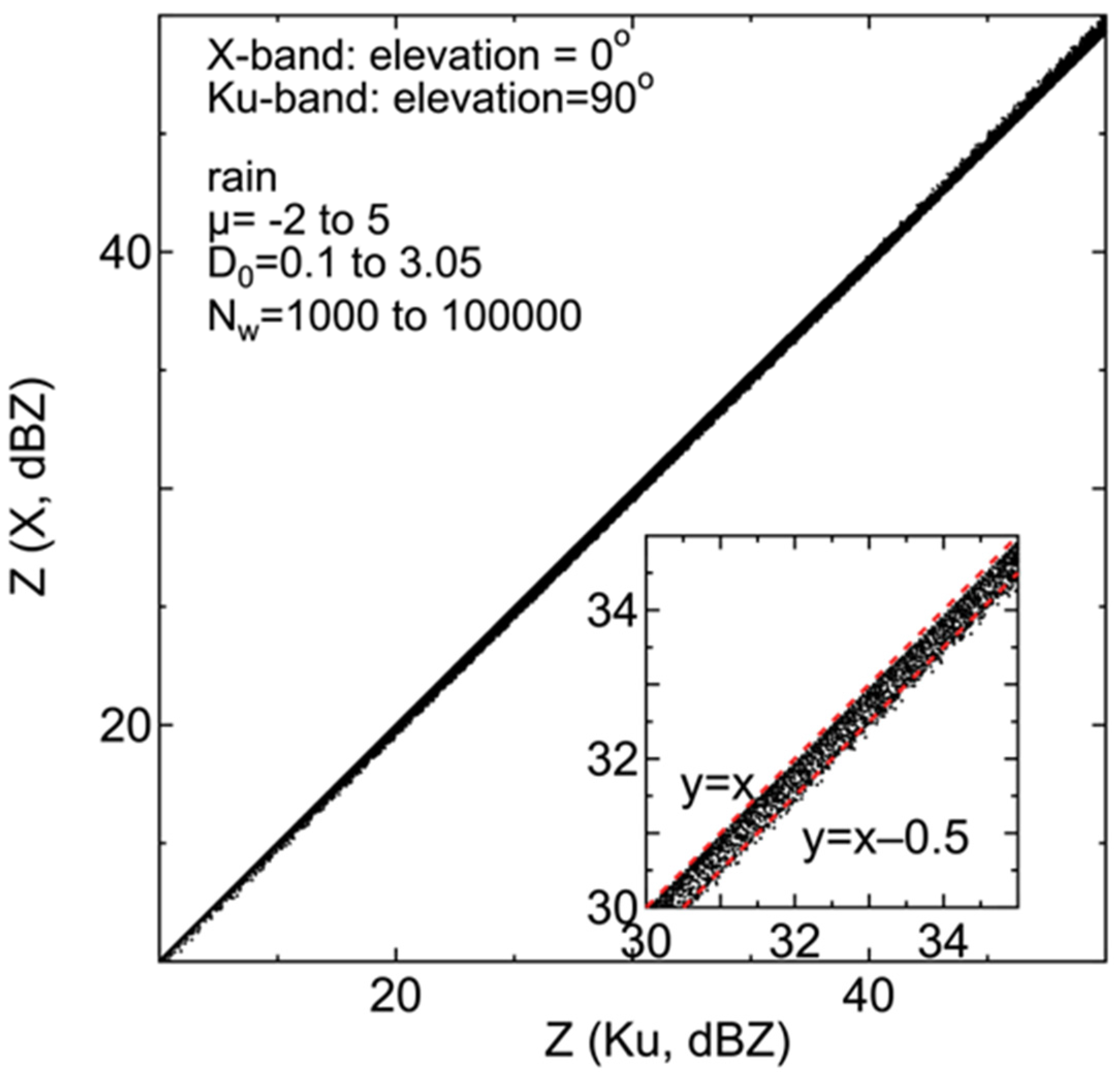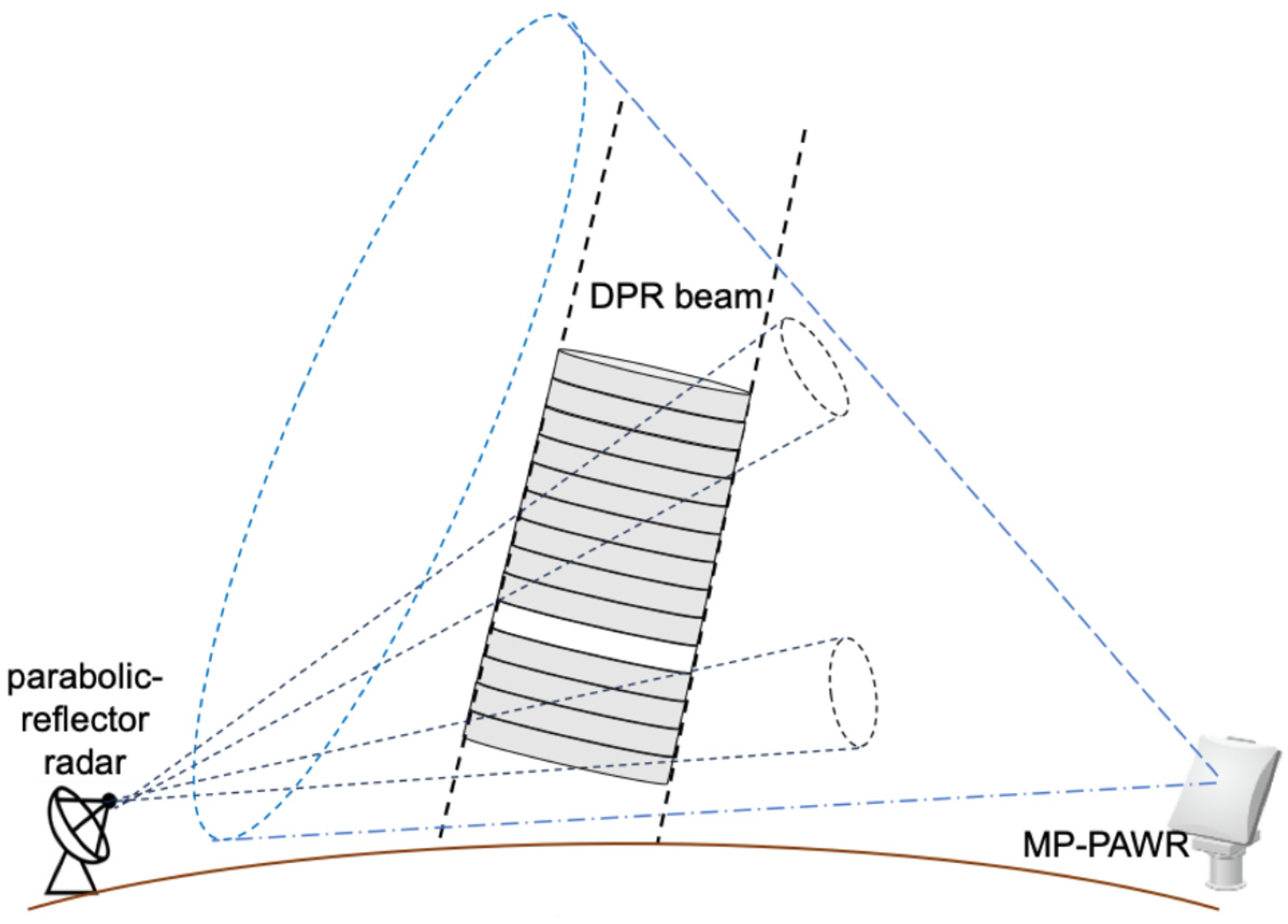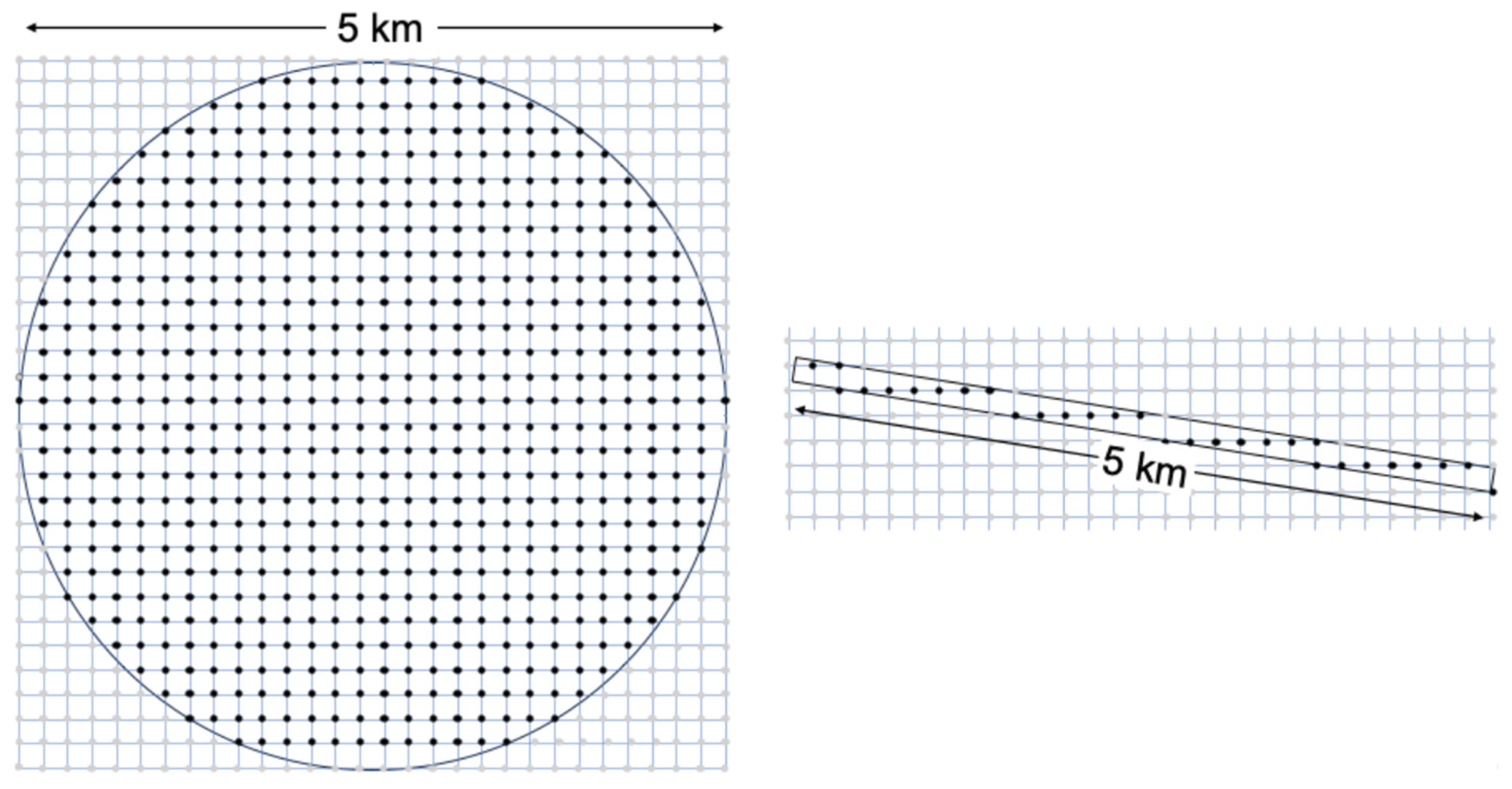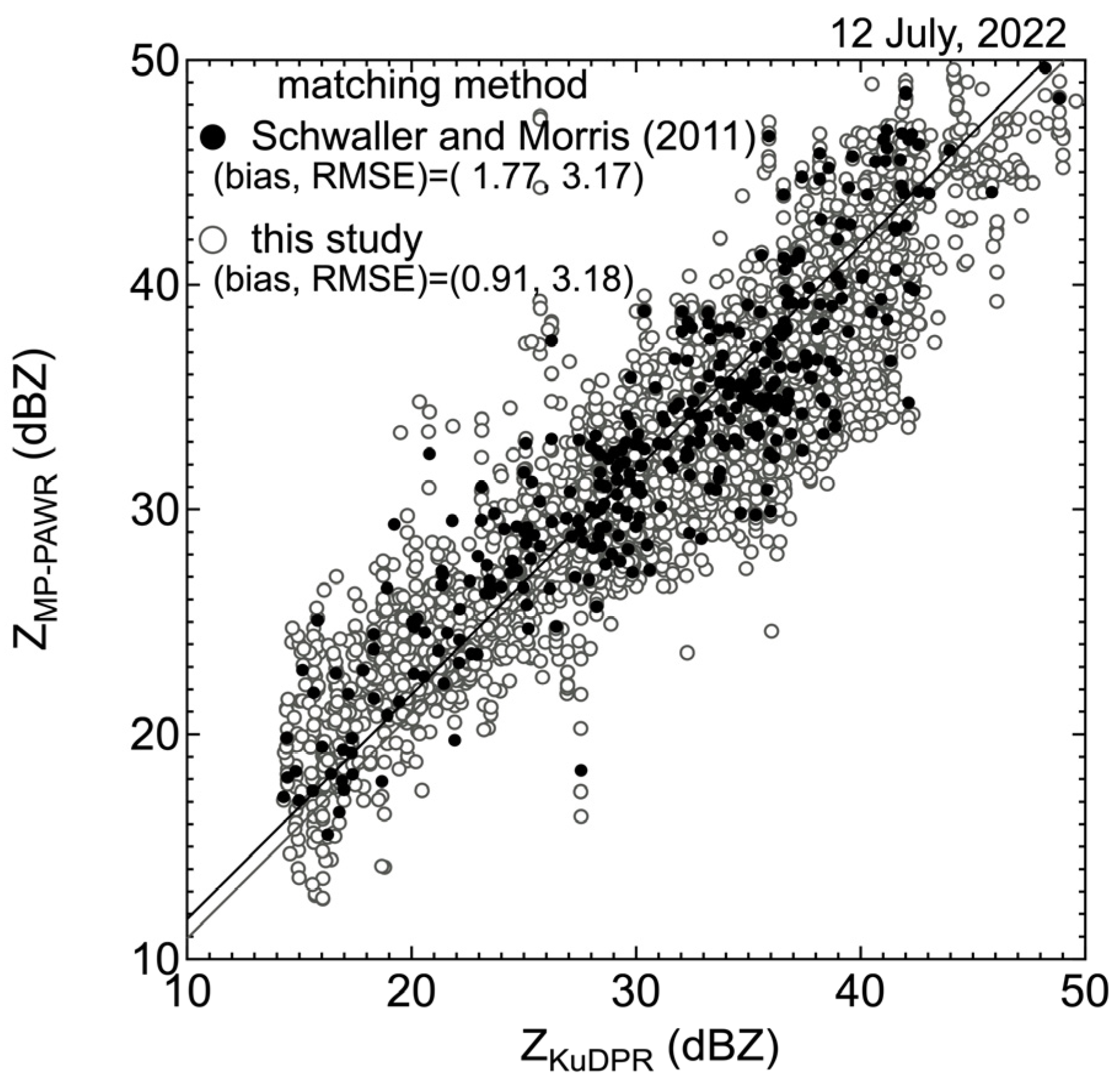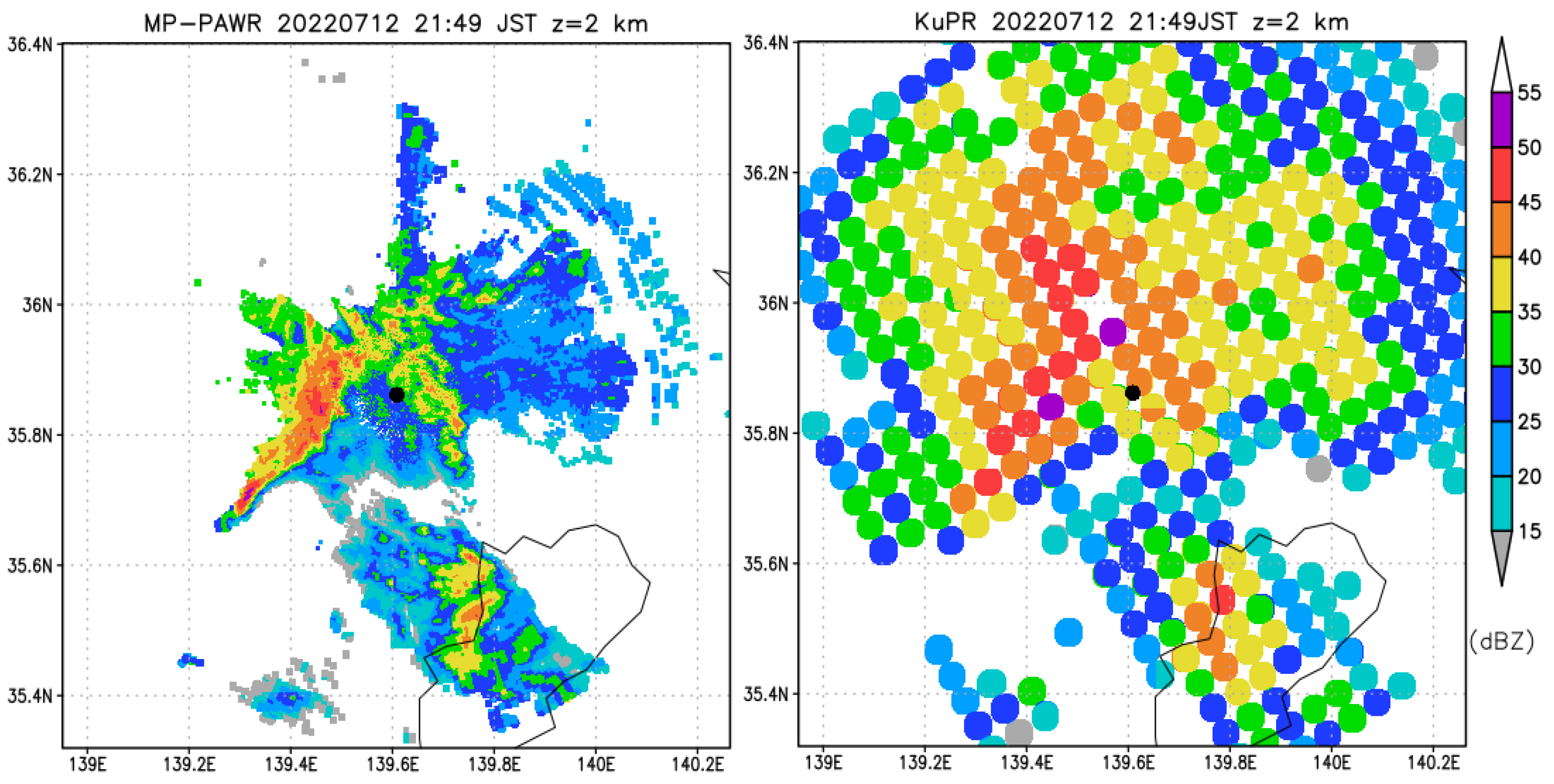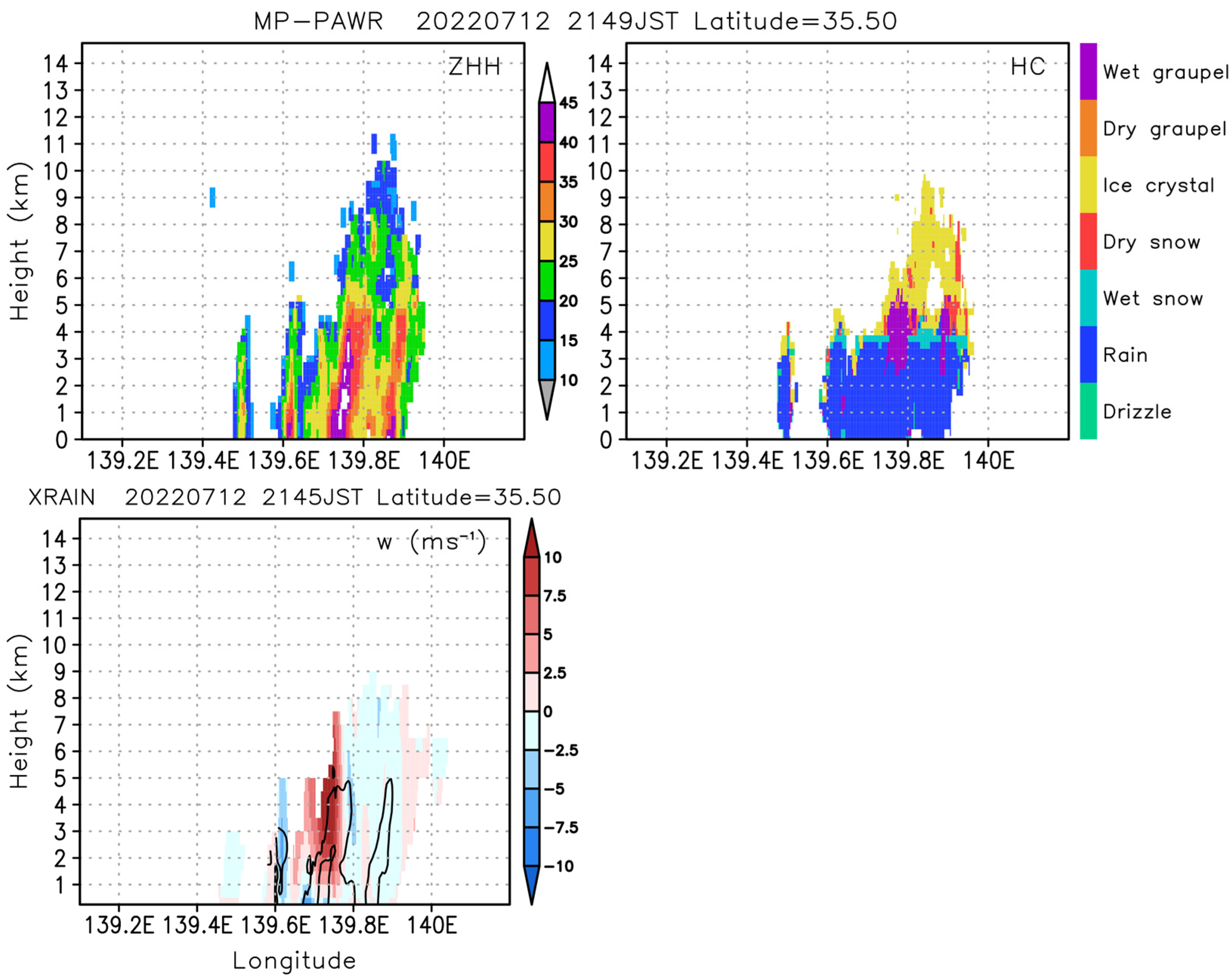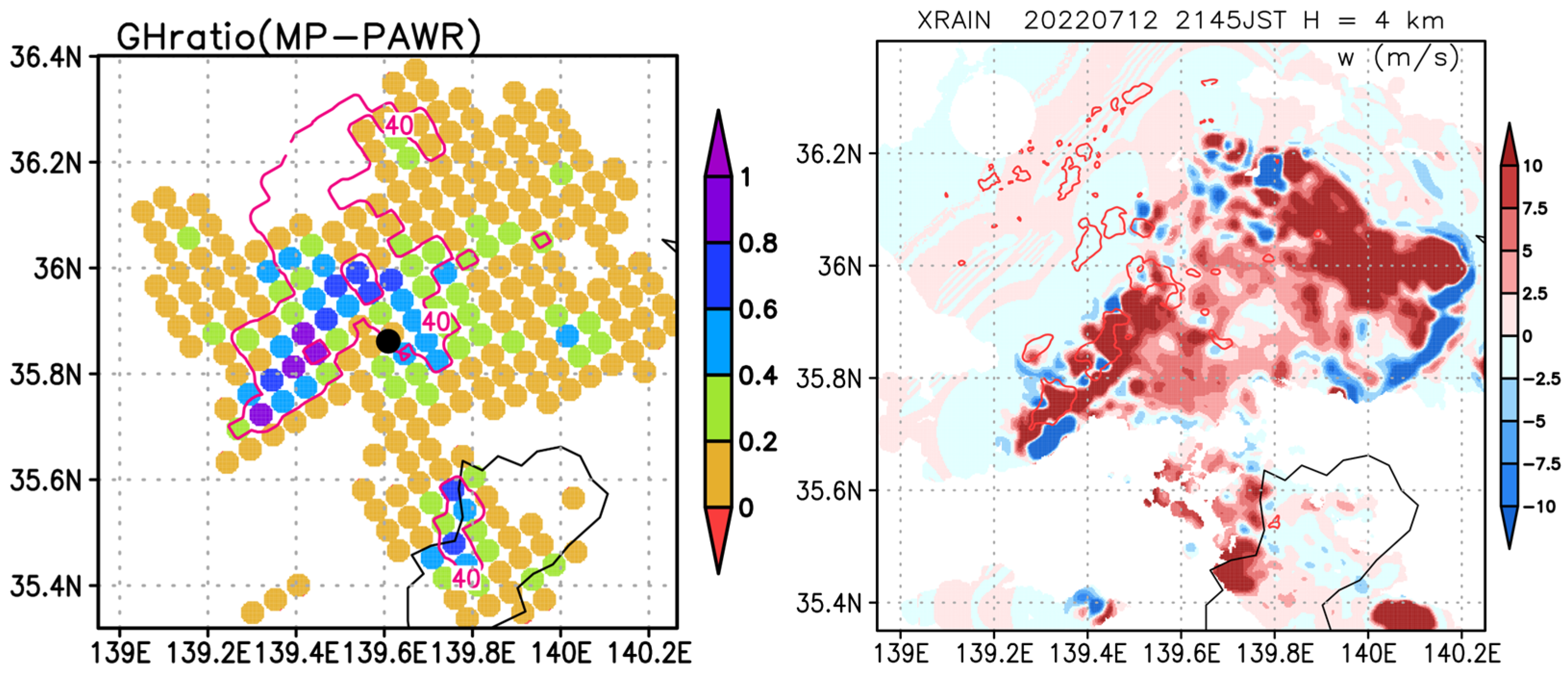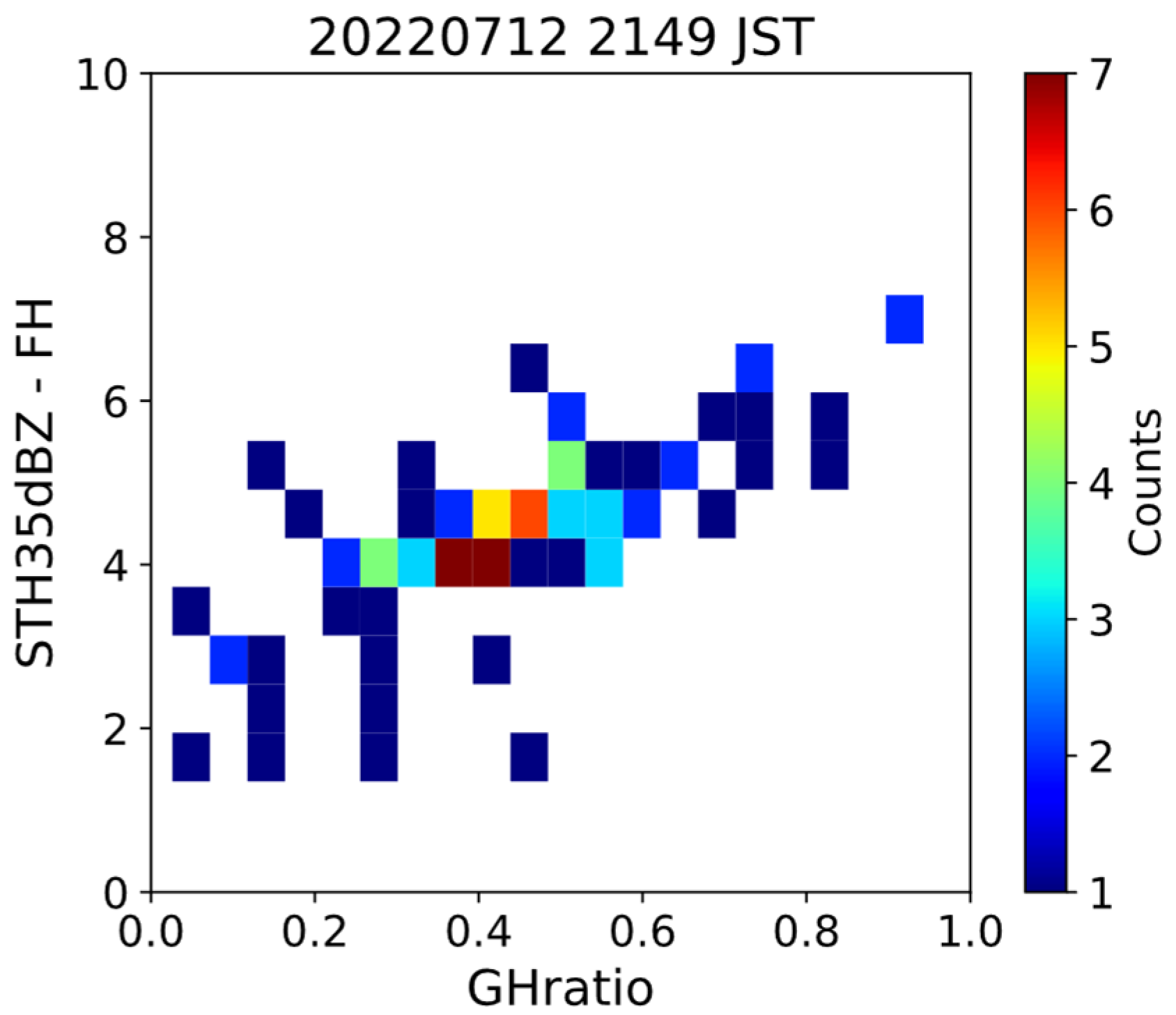1. Introduction
Understanding global precipitation systems is essential for improving weather forecasting, climate modeling, and disaster mitigation. Solid precipitation, such as hail, graupel, and large snowflakes, plays a particularly important role in severe convective storms, yet it remains one of the most challenging forms of precipitation to observe accurately because of its localized, transient, and hazardous nature [
1,
2,
3]. The Global Precipitation Measurement (GPM; [
4]) mission, led by National Aeronautics and Space Administration (NASA) and Japan Aerospace Exploration Agency (JAXA), aims to advance global precipitation observation capabilities. The GPM Core Observatory is equipped with a Dual-Frequency Precipitation Radar (DPR), which consists of Ku-band and Ka-band radars, referred to as KuPR and KaPR, respectively. DPR provides three-dimensional precipitation structures by retrieving vertical reflectivity profiles, and it includes algorithms dedicated to detecting and classifying large solid hydrometeors, such as hail and graupel [
5].
Recent updates to the DPR product (Version 07; [
6]) include flags, such as flagHail, flagGraupelHail [
7,
8], and flagHeavyIcePrecip [
9], which represent hail, graupel–hail mixtures, and large solid hydrometeors, respectively. These products have the potential to greatly enhance our understanding of solid precipitation processes on a global scale. However, validating these products remains challenging. Takahashi and Kurosawa [
5] compared these products in terms of the vertical profile of the radar reflectivity factor (Z), the measured dual-frequency ratio (DFRm), the mass weighted mean diameter (D
0), and the normalized intercept parameter (Nw) derived from DPR data. They found that the occurrence of these parameters showed limited overlap, indicating the need for further subdivision. Ideally, in situ observations would allow for better evaluation, but they are extremely dangerous within hail-producing convective clouds. Aircraft-based measurements are hazardous, and balloon observations have difficulty accurately targeting the region where graupel and/or hail form, necessitating the use of remote sensing approaches [
10].
Ground-based dual-polarization weather radar provides additional microphysical information and has been widely used to classify hydrometeor types more accurately than satellite-based radar. Nevertheless, operational scanning weather radar typically requires 5–10 min to complete a full three-dimensional volume scan, and its elevation coverage is limited. These constraints hinder direct comparison with fast-moving satellite observations and rapidly evolving severe convective clouds [
11].
Phased Array Weather Radar (PAWR), such as that described by Takahashi et al. [
12,
13], overcomes many of these limitations. The Multi-Parameter Phased Array Weather Radar (MP-PAWR) acquires three-dimensional dual-polarization observations every 30 s within a 60 km radius using 115 elevation angles ranging from 0° to 90°, making it highly suitable for satellite product validation [
12].
In this study, we evaluated the solid precipitation products of the GPM DPR using high-temporal-resolution data from the MP-PAWR located near Tokyo, Japan. The objectives of this study are the following: (1) to evaluate the DPR flagGraupelHail product in a humid convective environment, (2) to develop an improved volume-matching approach between DPR and MP-PAWR, and (3) to propose an additional index to enhance graupel and hail detection performance by DPR. We focus on flagGraupelHail and compare its classification with that derived from dual-polarization PAWR data. In addition to flagGraupelHail, other potentially relevant indicators include flagHail, flagHeavyIcePrecip, and the multiple scattering index (MSindex), which may indicate the presence of hail [
14]. This comparative analysis aims to assess the accuracy of DPR solid precipitation retrievals and provide insights for future algorithm improvements.
Previous validation studies have mainly focused on continental or semi-arid regions. For example, comparisons using the operational S-band dual-polarization radar network over the United States demonstrated reasonable correspondence with ground-based radar, and a case study of a large hail event over Italy compared hydrometeor types derived from both DPR and ground-based radar [
7,
8]. Therefore, the performance of DPR solid precipitation algorithms in humid subtropical environments remains poorly understood. This study addresses this gap using Japan’s MP-PAWR system, which provides high-temporal-resolution 3D dual-polarization data.
We analyzed a case from 12 July 2022, when the GPM Core Observatory passed over the MP-PAWR observation domain at 21:49 JST (Japan Standard Time). On that day, convective precipitation developed between 16:00 and 22:00 JST, and heavy rainfall—110 mm from 19:00 to 20:00 JST and 263.5 mm from 17:00 to 20:00 JST—was reported by the Japan Meteorological Agency’s AMeDAS (Automatic Meteorological Data Acquisition System) in the northwestern part of MP-PAWR’s observation domain. In this case, deep convection likely occurred, capable of producing hail and graupel. However, no hail was reported by ground-based observations. When the satellite passed over the MP-PAWR’s observation range, 4.5 mm of precipitation was recorded in 10 min at the AMeDAS Saitama station (near the MP-PAWR site), 10 mm of precipitation 10 min before the overpass, 7 mm at the AMeDAS Tokorozawa station (about 15 km west–southwest of the MP-PAWR site), and 15 mm of precipitation 10 min after the overpass.
Figure 1 shows the region of heavy precipitation located within the MP-PAWR range and XRAIN [
15] radars (KANTOU, FUNABASHI, SHINYOKO and YATTAJIMA) ranges based on the surface precipitation rate estimated by DPR. This region was classified as convective precipitation according to the DPR product (typePrecip). These results indicate that the precipitation system observed during the GPM overpass can be characterized as convective precipitation.
2. Data Collection and Analysis
The MP-PAWR used in this study operates in the X-band and is located in Saitama City, approximately 30 km north of central Tokyo (
Figure 1). MP-PAWR employs a fan beam for transmission and a pencil beam for reception, utilizing digital beamforming technology to perform rapid Range–Height Indicator (RHI) scans from 0° to 90° elevation in approximately 0.1 s. By rotating the antenna in azimuth, it acquires complete three-dimensional volumetric data. In practice, the radar observes altitudes up to 15 km within a 60 km radius, using 115 elevation angles. Its sensitivity is sufficient to detect precipitation signals down to 10 dBZ [
12,
13]. MP-PAWR simultaneously transmits horizontal and vertical polarized waves and receives both components. It outputs the received power, Z, and Doppler velocity of both polarization and differential reflectivity (ZDR), the phase difference due to propagation between horizontal and vertical polarization (ΦDP), and the correlation coefficient between horizontal and vertical polarization (ρHV).
Given the hybrid fan–pencil beam design of the phased array system, elevation-dependent bias corrections of Z and differential reflectivity (ZDR) are necessary. In this study, we applied the method proposed by Gourley et al. [
16], which exploits the relative independence of the KDP/Z–ZDR relationship from the drop size distribution, to correct biases in Z and ZDR. However, at higher elevation angles, the variability of ZDR and KDP relative to Z decreases, making this method less reliable. Therefore, we first applied the method of [
16] to XRAIN—a dual-polarization X-band radar network employing conventional parabolic antennas [
11] with a maximum elevation angle of 20°—and generated grid-based match-up datasets between XRAIN and MP-PAWR by selecting less attenuated regions where the time difference between observations was less than 1 min. It should be noted that the XRAIN radars are corrected independently and confirmed the consistency of the corrected bias by comparing relative bias between two radars. These datasets were then used to derive elevation-specific bias corrections for MP-PAWR. In this study, we used four XRAIN radars—KANTOU, SHINYOKO, FUNABASHI, and YATTAJIMA—surrounding MP-PAWR (see
Figure 1 for their locations). Absolute bias correction for XRAIN was implemented using the method in [
16]. First, XRAIN radar data were converted from polar to Cartesian coordinates with horizontal and vertical resolutions of 0.25 km and 0.5 km, respectively, and match-up datasets were created for Z and ZDR. Second, an average ZDR-KDP/Z dataset was created for each radar, and the Z and ZDR biases were estimated by fitting the observed data to the theoretical ZDR-KDP/Z curve while adjusting the bias values of Z and ZDR in 1.0 dB and 0.5 dB intervals. The estimated biases were evaluated using match-up data from less-attenuated regions. By taking the difference in absolute biases between two radars, the relative bias could then be estimated and compared with that derived from the match-up data.
Because both MP-PAWR and XRAIN operate in the X-band, attenuation corrections for Z and ZDR using KDP were applied at elevation angles below 30°, whereas for higher angles corrections were performed based on the attenuation coefficient (k)–Z relationships for horizontal and vertical polarization below the freezing level.
Figure 2 compares the two-dimensional histograms of Z between MP-PAWR and GPM KuPR before and after bias correction of MP-PAWR. According to [
17], KuPR is well-calibrated using active radar calibrators, the normalized surface backscattering cross-section over the ocean, and internal calibration procedures. The left panel in
Figure 2 shows a large negative bias of approximately −5 dB for MP-PAWR, whereas the bias is greatly improved to 0.91 after correction. A slight improvement in the root mean square error (RMSE) and the correlation coefficient (Corr) are also evident in
Figure 2.
For hydrometeor classification using MP-PAWR, we employed the method of Kouketsu et al. [
18], an X-band fuzzy-logic-based classification algorithm that identifies eight hydrometeor types: drizzle, rain, ice crystals, wet snow, dry snow, wet graupel, dry graupel, and rain and hail. This method was only applied to elevation angles below 30°. Data within a radius of approximately 10 km could not be analyzed when focusing on hydrometeor types below 6 km (approximately 1 km above the freezing level) in the later analysis. For comparison with DPR solid precipitation products, we focused on the three categories relevant to graupel and hail: wet graupel, dry graupel, and rain and hail.
The DPR data used in this study correspond to flagGraupelHail, an experimental product in Version 07. This flag enhances graupel detectability by adjusting the threshold values used in the standard flagHail product. Note that the flag is defined for each angle bin in the radar observations and does not provide full three-dimensional hydrometeor-type profiles in this version.
To compare MP-PAWR and DPR, we examined Z observed by MP-PAWR and KuPR. Differences in observation geometry, frequency, and sampling volume between spaceborne and ground-based radar must be taken into account [
19,
20]. The impacts of geometry and frequency were evaluated by simulating Z values using the T-matrix method [
21] over a range of drop size distributions modeled with gamma functions [
22]. Assuming a nadir-looking geometry for KuPR (90° elevation) and a near-horizontal scan for XRAIN (0° elevation), the KuPR reflectivity factor was found to be comparable to, or up to 0.5 dB higher than, that of the X-band (see
Figure 3).
Regarding volume differences, averaging methods, such as those proposed by [
19,
20], adjust the spatial volumes between ground-based radar (parabolic reflector radar;
Figure 4) and DPR by averaging over larger observation volumes. However, because this study focuses on evaluating hail and graupel detections—phenomena that are highly localized—such spatial averaging may not be appropriate. Instead, we gridded the high-resolution MP-PAWR data onto 0.25 × 0.25 × 0.25 km grids and convolved them with the DPR antenna pattern to simulate DPR observation volumes, assuming a 5 km of footprint diameter and 0.25 km range resolution.
Figure 5 illustrates the number of MP-PAWR grid cells included within a single DPR observation volume. More than 300 grid cells were averaged to represent one DPR observation volume (grid-matching method). Averaging was performed within the DPR footprint, weighted by a Gaussian antenna pattern (−6 dB beamwidth), allowing for direct comparison between MP-PAWR and DPR.
Figure 4 schematically illustrates the difference between MP-PAWR and a conventional parabolic reflector radar observations. It should be emphasized that MP-PAWR performs electrical RHI scans (115 elevation angles) while mechanically rotating the antenna in azimuth to complete three-dimensional observations within 30 s. Therefore, the MP-PAWR observations are nearly simultaneous with those of DPR, even for convective clouds, and the MP-PAWR data contain no spatial gaps. Gridded data with 0.25 km horizontal and vertical resolution were created by resampling the densely observed raw data after bias and attenuation correction.
Figure 6 compares scatterplots generated using both the conventional volume-averaging method (e.g., [
20]) and the proposed grid-matching method. The grid-matching method achieves less bias (0.91 dB compared to 1.77 dB for the volume-averaging method), and the RMSE is similar, indicating that most data points are concentrated along the diagonal line, although many points show larger deviations. Because comparisons using larger volumes (e.g., the method of [
20]) tend to filter out extreme values, our method performs comparably to the conventional one, and it was therefore adopted for further analysis. In addition, because the volume-averaging method requires larger sampling volumes, only 339 points were compared between ground-based and spaceborne radar, whereas 3,293 points were compared using the grid-matching method, indicating that the conventional method is not suitable for detailed analysis. This grid-matching approach is feasible only with full-volume scan observations, such as those from MP-PAWR.
This approach, which compares each sampling volume of the DPR, also enables direct comparison of hail and graupel detection between MP-PAWR and DPR. The DPR graupel and hail detection algorithm [
7,
8] uses the Parameterized Textural Index (PTI), defined as
where the numerator represents the mean absolute vertical gradient of the observed dual-frequency ratio (DFR
m = Z
m(Ku)/Z
m(Ka)) and Z
m(Ku) and Zm(Ka) denote the observed radar reflectivity factors of KuPR and KaPR, respectively. The subscript
m denotes measured values, i.e., those uncorrected for attenuation. The denominator represents the product of the storm-top height and the maximum Ku-band reflectivity factor (Z
m(Ku)
max). The algorithm flags graupel or hail when PTI falls below a threshold of 5.5 near nadir and 4.6 elsewhere and specifically identifies hail when PTI is below 3.5. Lower PTI values indicate a greater likelihood of hail relative to graupel. Because this flag is assigned for each ray of DPR rather than each sampling volume, PTI values for each DPR angle bin were computed using the method in [
5] and compared with hydrometeor classifications derived from MP-PAWR. Because MP-PAWR assigns a hydrometeor class to each 0.25 km
3 grid cell, the graupel–hail ratio (GHratio) was defined as
where
is the number of grid cells classified as either “wet graupel” or “rain and hail” and
is the total number of grid cells within the DPR sampling volume. The GHratio was computed within a vertical layer of ±1 km around the 0 °C level to detect falling graupel or hail before melting, where most wet graupel was detected. A higher GHratio indicates a greater probability of graupel or hail being present.
To examine the formation and dynamics of graupel and hail within the cloud, we implemented dual-Doppler analysis using four XRAIN radars deployed around Tokyo (
Figure 1). XRAIN performs PPI scans at 12 elevation angles from 1° to 20° within a 5 min cycle. Dual-Doppler wind fields were retrieved using Python-based pyDDA (ver. 1.5) software [
23] by constructing the three-dimensional gridded data on a common grid for each radar. Because the XRAIN scan cycle is slower than MP-PAWR’s 30 s cycle, we used the three-dimensional wind field data obtained closest to the GPM overpass (21:45–21:49 JST).
4. Discussion
Previous evaluations of DPR graupel/hail-related products, such as flagHail and flagGraupelHail, have mainly been conducted in the United States using hydrometeors from the NEXRAD radar network and in a case study of a large hail event over Italy [
7,
8]. These studies reported good consistency between DPR detections and hydrometeor classifications obtained from ground-based observations. However, evaluations outside of the United States, particularly in humid climates, remain limited. This is because the likelihood of simultaneous thunderstorm observation by both DPR and ground-based radar is low, and few dual-polarization radars can cover higher altitudes above the freezing level.
The present study provides, for the first time, an evaluation of flagGraupelHail in convective systems that developed under moist environmental conditions typical of the region around Tokyo, Japan (35° to 36°N) during summer. In moist environments, updraft speeds in convective clouds are weaker than those in drier regions, such as the United States. Consequently, hail sizes tend to be smaller, and wet graupel is likely to occur. In this case, the CAPE was approximately 1200 J kg−1, and the freezing level was around 5.5 km, consistent with moist maritime air masses. In this study, we employed a hydrometeor classification algorithm for X-band radar, which is more sensitive to weaker precipitation than S-band radars, partly due to the higher sensitivity of KDP.
The analysis indicates that the graupel region estimated from MP-PAWR is generally larger than that identified by DPR (flagGraupelHail). In other words, the current PTI thresholds employed by DPR may be too low for effective detection of graupel and hail under such humid environmental conditions. Specifically, our analysis revealed several cases in which MP-PAWR detected significant graupel signatures (high GHratio), while the DPR flagGraupelHail remained inactive. Conversely, there were also cases where flagGraupelHail was detected in regions showing only weak graupel or hail signals in the MP-PAWR observations. This inconsistency suggests that PTI alone may not fully capture the complexities of graupel and hail occurrence, particularly in moist atmospheric conditions where the microphysical processes differ from those in drier regions, such as the central United States. As shown in Equation (1), the PTI value is calculated based on the slope of DFRm, storm-top height, and maximum reflectivity. Severe thunderstorms over the United States show extremely high Z and storm-top heights corresponding to large CAPE values, whereas thunderstorms in humid regions, such as Japan, have relatively weak Z and low storm-top heights, consistent with moderate CAPE values. Therefore, the PTI threshold should be adjusted according to regional conditions, or additional constraints should be introduced to improve graupel/hail detection.
It should be emphasized that MP-PAWR provides high-temporal-resolution (30 s) and high-spatial-resolution dual-polarization data without spatial gaps. Therefore, MP-PAWR observations offer much greater temporal and spatial overlap with spaceborne radar than previous comparisons using conventional parabolic antenna radars. It should be noted that we excluded both the blind zone caused by nearby buildings and regions heavily affected by attenuation in this study. The latter is an unavoidable issue for X-band radar. The reliability of MP-PAWR hydrometeor classification is subject to uncertainties arising from attenuation corrections applied to both reflectivity and differential reflectivity. When attenuation correction for Z is overestimated, the corresponding correction for ZDR also tends to become excessive. According to the method proposed by [
18], this may lead to misclassifications, such as from dry graupel to wet graupel or from wet graupel to rain and hail categories. In addition, overestimation of ZDR can change the hydrometeor type from graupel to rain. As shown in
Figure 2, which compares the attenuation-corrected Z between KuPR and MP-PAWR, the uncertainty of Z is approximately 3 dB. This value does not have a significant impact on graupel (dry/wet) determination when discussing Z values around 40 dBZ, as shown in [
18]. ZDR uncertainty is approximately 0.5 dB based on our bias correction method, which does not affect graupel classification. In the present study, the absence of dry graupel near the 0 °C level suggests that the attenuation corrections applied were reasonably accurate.
Our results further suggest that incorporating the height of strong reflectivity cores relative to the 0 °C level—specifically, the STH35-FH parameter (defined as the height of the 35 dBZ echo above the freezing level)—can enhance the accuracy of graupel and hail detection. The GHratio calculated from DPR data using STH35-FH with a relaxed PTI threshold of 10 corresponded reasonably well with the GHratio derived from MP-PAWR. Introducing STH35-FH into the DPR algorithm improved the consistency between DPR detections and MP-PAWR observations, particularly by reducing false positives in regions with weak graupel or hail occurrence. In this study, the GHratio was calculated between 1 km below and 1 km above the 0 °C level, as most graupel signals appeared within that height range. Further approaches should be considered to detect graupel occurring at higher altitudes (>1 km above the 0 °C level).
This finding is consistent with previous hail detection methodologies emphasizing the importance of the vertical echo structure [
27,
29]. Stronger updrafts are required to sustain the growth of graupel and hail, resulting in elevated reflectivity cores above the melting level. The STH35-FH parameter effectively captures this physical characteristic, making it a promising candidate for incorporation into future DPR retrieval algorithms. The freezing level in this region during summer reaches approximately 5 km. Therefore, using the echo top height from the 0 °C level implies that it can more appropriately represent convective systems producing hail or graupel than simply using the echo top height in PTI. This suggests that STH35-FH may not be globally applicable. It should be noted that this algorithm is only applicable in cases of deep convection in which the echo top is sufficiently high above the freezing level (>2 km).
Furthermore, our analysis highlights the value of high-resolution ground-based radar networks, such as MP-PAWR, in complementing satellite-based observations. The rapid volumetric scanning capability of MP-PAWR enables the capture of rapidly evolving convective structures, providing insights that are difficult to obtain from spaceborne platforms alone. Integration of MP-PAWR and DPR data could thus contribute to refining global precipitation products and improving their applicability across diverse climatic regimes.
This study demonstrates the limitations of the current PTI-based approach in humid environments and proposes the incorporation of STH35-FH as a physically meaningful and operationally feasible enhancement to the flagGraupelHail algorithm. Future work should further examine the robustness of this approach across different storm types and climatic regimes and investigate additional microphysical indicators that could complement existing DPR detection frameworks.
5. Conclusions
In this study, we evaluated the performance of the flagGraupelHail product from the Dual-Frequency Precipitation Radar aboard the GPM Core Observatory using high-resolution, dual-polarization observations from MP-PAWR. Our analysis focused on a convective system that developed in a humid environment over the Tokyo region of Japan, providing a valuable assessment in a climatic regime that has been underrepresented in previous studies.
First, we developed a new match-up method between MP-PAWR and DPR, taking advantage of MP-PAWR’s gap-free volumetric scan, which requires only 30 s for full 3D observation. In this study, MP-PAWR data were gridded at a 0.25 km resolution, and all grid points within each DPR beam (range resolution of 250 m) were averaged and compared with DPR observations. Comparison with the preceding method [
17] indicated that our approach agrees reasonably well with that of [
17]. This method enables direct comparison with the original volumetric data of DPR. Second, bias correction for radar reflectivity in MP-PAWR was implemented using match-up data from the well-calibrated XRAIN radar network. The applied correction proved effective, yielding good agreement with KuPR reflectivity observations (bias ≈ 0.9 dB; RMSE ≈ 1.8 dB). MP-PAWR successfully captured fine-scale vertical structures of the precipitation system, including graupel and hail signatures, owing to its high temporal and spatial resolution.
Our comparison revealed that although DPR’s flagGraupelHail product generally corresponded to regions with high graupel or hail occurrence, as indicated by the MP-PAWR GHratio, notable discrepancies remained. Specifically, DPR tended to miss some regions with high graupel concentrations while also flagging graupel or hail in areas where MP-PAWR detected little to no such hydrometeors. These findings suggest that the current PTI-based detection algorithm, though effective in some environments, may not be fully optimized for humid conditions, such as those observed in this study.
To address this issue, we incorporated an alternative indicator, the height of the 35 dBZ echo relative to the 0 °C level (STH35-FH). This parameter effectively captured the vertical development of strong echoes associated with the growth of graupel and hail. By introducing STH35-FH with a relaxed PTI threshold of 10, graupel detection by DPR became more consistent with MP-PAWR observations, reducing false positives and enhancing detection accuracy. This study demonstrated improvements to the algorithm under humid conditions, but further investigation is needed to identify parameters applicable to various environments.
Our results highlight the importance of tailoring graupel and hail detection algorithms to account for environmental variability, particularly in humid climates where storm dynamics and microphysical processes differ from those in drier regions. The findings also demonstrate the value of synergistically combining spaceborne and ground-based radar observations to improve global precipitation retrieval.
Future work should extend this analysis to multiple storm cases across diverse climatic regions to further validate the proposed improvements. Because there were few overflight cases from the GPM Core Observatory within the MP-PAWR observation range during deep convection events, we conducted a case study. Additionally, incorporating other microphysical and dynamical indicators, such as updraft strength and dual-polarization signatures, could enhance the robustness of DPR’s solid precipitation products.
In conclusion, this study provides new insights into the detection of graupel and hail using spaceborne radar observations in humid environments, highlighting the potential of high-resolution phased array radar for improving satellite-based solid precipitation retrievals and advancing our understanding of graupel and hail microphysics in humid regions.

